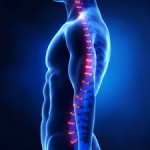What is ‘subluxation’ and why can’t my body heal itself?
 As Kanata Chiropractors, we are always talking about “subluxation” – a misalignment of the vertebrae in your spine. We often discuss the negative effects of a subluxation and the importance of correcting it.
As Kanata Chiropractors, we are always talking about “subluxation” – a misalignment of the vertebrae in your spine. We often discuss the negative effects of a subluxation and the importance of correcting it.
But what causes it? And why can’t such a complex and dynamic machine like the human body, which can heal torn flesh and mend broken bones, not recover on its own from a misalignment?
First, let’s review the three contributors to a subluxation, what are often called “the three Ts”:
Trauma:
This is the obvious one. Injury to your spine can be caused by an obvious one-time event, like a fall, a bad hit during contact sports, or a car accident. Or it can be subtle trauma that builds over time from constant repetitive behaviour, like the mail carrier who always has a heavy bag slung over one shoulder, the office worker who is always hunched over a keyboard, or even your friendly neighbourhood Kanata Chiropractor, who is always doing patient adjustments from the same side of the table.
Toxins:
This encompasses any number of things. It can include what you eat, such as added sugar and trans-fats that cause inflammation, chemical toxins from plastics and pesticides that cause hormone imbalances, and a lack of a key vitamin or mineral in your diet that is key to healthy bones and tissues, such as calcium.
The net effect of any combination of the above is that the body’s natural healthy function, its ability to heal and operate at peak efficiency, is impaired.
Thoughts:
When you are stressed – what happens? You lose sleep, you get tense and hunched in the shoulders and neck – your muscles get all knotted, which pulls on your vertebrae. And how many of us can say we are not stressed, about work, about money, about the relationships in our life, or the state of the world in general?
So, does your mental state contribute to a subluxation? Oh, yeah. Some in our profession argue your mental state can have the greatest impact on your spinal health versus Trauma and Toxins. This is partly because stress and lack of sleep contribute to those hormone imbalances we mentioned in Toxins.
So why can’t my body heal itself?
It just might, if it could catch enough of a break from the abuse and neglect it suffers every day.
What we mean is that your body can heal itself, as long as it does not become “overwhelmed”, as long as the ratio of stresses vs. healing capacity stays balanced.
What can you do to help? Stretch and massage those knotted muscles, on a daily basis. Avoid all those repetitive behaviours that constantly put stress on the vertebrae and the soft tissues connected to them. Eat clean, get enough sleep, and effectively manage your stress.
If you can do all that, please share your secret with the rest of the world. We would like nothing better than to be out of a job because subluxations have all but vanished except among those who suffer a traumatic injury.
But that’s just not reality.
Your spine is a dynamic system that is meant to move. But a sudden traumatic event, or constant repetitive behaviour, weakens the spine’s ability to restore its own proper alignment when at rest. Nerves relay signals from the body to the brain. These signals govern function and healing. The stress of a subluxation from an accident or repetitive behaviour causes impairment of these nerves, and the muscles, ligaments, and tendons they control. Your spine loses its ability to self-heal without outside help; it’s “out of balance”.
Let this go long enough, and the actual shape of the surfaces where two vertebrae align with each other will start to degenerate. This may result in a chronic subluxation. We can see several examples of this in the x-rays of our patients. Unfortunately, chronic subluxations may never be fully reversible due to the underlying damage.
That’s why screenings are so important
We therefore recommend, as we did in last week’s post, regular screenings of your spinal health.
The key is to catch a subluxation before it becomes a chronic one. To give your body that little bit of extra help it needs to heal itself. The nature of that help of course depends on your individual situation – the severity of your subluxation, your lifestyle habits, and how diligently you follow the homework we might give you to stretch or strengthen key ligaments and muscles.
